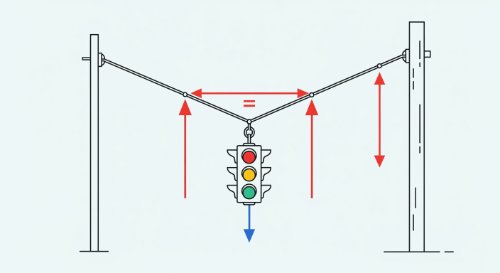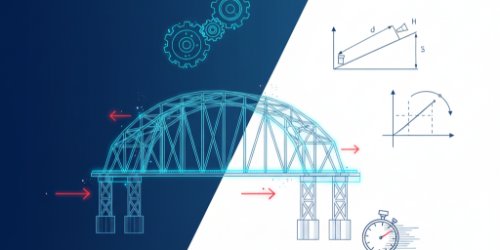Worked examples (17) - Components of a Force in Space | Statics of Particles - Engineering Mechanics (Undergraduate Advanced)
SPONSORED Get Personalized Tutoring NowStruggling with a tough concept or looking to advance your skills? Our expert tutors offer one-to-one guidance tailored to your unique needs.
Get instant support, clear explanations, and practical strategies to master even the most challenging subjects. With flexible scheduling and customized learning plans, success is just a session away.
Book your personalized tutoring today and start achieving your academic goals!
Get Personalized Tutoring NowStruggling with a tough concept or looking to advance your skills? Our expert tutors offer one-to-one guidance tailored to your unique needs.
Get instant support, clear explanations, and practical strategies to master even the most challenging subjects. With flexible scheduling and customized learning plans, success is just a session away.
Book your personalized tutoring today and start achieving your academic goals!
Struggling with a tough concept or looking to advance your skills? Our expert tutors offer one-to-one guidance tailored to your unique needs. Get instant support, clear explanations, and practical strategies to master even the most challenging subjects. With flexible scheduling and customized learning plans, success is just a session away. Book your personalized tutoring today and start achieving your academic goals!
 Statics of Particles - Engineering Mechanics (Undergraduate Advanced)This course provides a complete guide to the statics of particles, a foundational topic in engineering mechanics. It covers the principles of force vectors, resultants, and components, first in two dimensions and then extending to three-dimensional space. The core of the course is the analysis of particles in equilibrium, establishing the conditions required for a particle to remain at rest under the influence of multiple concurrent forces.
Statics is the essential science behind structural and mechanical design. The principles covered are the basis for designing every stable structure, from bridges and skyscrapers to aircraft frames and engine components. A command of statics is non-negotiable for any engineer, as it provides the fundamental tools required to analyse forces and ensure the safety and integrity of physical systems.
By the end of this course, you will be able to resolve any force into its components and calculate the resultant of any system of concurrent forces in both 2D and 3D. You will also be able to draw a complete free-body diagram for any particle and apply the equations of equilibrium to solve for unknown forces, tensions, and reactions in a variety of engineering problems.
This course is for undergraduate students in any engineering discipline, including civil, mechanical, and aerospace. It is a core component of any engineering mechanics curriculum and assumes a prerequisite knowledge of introductory physics and vector mathematics. It is the essential foundation for subsequent courses in dynamics and the mechanics of materials.
Statics of Particles - Engineering Mechanics (Undergraduate Advanced)This course provides a complete guide to the statics of particles, a foundational topic in engineering mechanics. It covers the principles of force vectors, resultants, and components, first in two dimensions and then extending to three-dimensional space. The core of the course is the analysis of particles in equilibrium, establishing the conditions required for a particle to remain at rest under the influence of multiple concurrent forces.
Statics is the essential science behind structural and mechanical design. The principles covered are the basis for designing every stable structure, from bridges and skyscrapers to aircraft frames and engine components. A command of statics is non-negotiable for any engineer, as it provides the fundamental tools required to analyse forces and ensure the safety and integrity of physical systems.
By the end of this course, you will be able to resolve any force into its components and calculate the resultant of any system of concurrent forces in both 2D and 3D. You will also be able to draw a complete free-body diagram for any particle and apply the equations of equilibrium to solve for unknown forces, tensions, and reactions in a variety of engineering problems.
This course is for undergraduate students in any engineering discipline, including civil, mechanical, and aerospace. It is a core component of any engineering mechanics curriculum and assumes a prerequisite knowledge of introductory physics and vector mathematics. It is the essential foundation for subsequent courses in dynamics and the mechanics of materials.
This course provides a complete guide to the statics of particles, a foundational topic in engineering mechanics. It covers the principles of force vectors, resultants, and components, first in two dimensions and then extending to three-dimensional space. The core of the course is the analysis of particles in equilibrium, establishing the conditions required for a particle to remain at rest under the influence of multiple concurrent forces. Statics is the essential science behind structural and mechanical design. The principles covered are the basis for designing every stable structure, from bridges and skyscrapers to aircraft frames and engine components. A command of statics is non-negotiable for any engineer, as it provides the fundamental tools required to analyse forces and ensure the safety and integrity of physical systems. By the end of this course, you will be able to resolve any force into its components and calculate the resultant of any system of concurrent forces in both 2D and 3D. You will also be able to draw a complete free-body diagram for any particle and apply the equations of equilibrium to solve for unknown forces, tensions, and reactions in a variety of engineering problems. This course is for undergraduate students in any engineering discipline, including civil, mechanical, and aerospace. It is a core component of any engineering mechanics curriculum and assumes a prerequisite knowledge of introductory physics and vector mathematics. It is the essential foundation for subsequent courses in dynamics and the mechanics of materials.
 MEE 205: Engineering Mechanics - StaticsMaster the science of structural stability. This programme provides a complete education in engineering statics, covering the analysis of forces, moments, and equilibrium in rigid bodies. It delivers the non-negotiable principles required to design safe and reliable structures.
This learning track is for first or second-year undergraduate students in Civil, Mechanical, Aerospace, and Structural Engineering. It is the foundational mechanics course upon which all subsequent design and analysis subjects are built.
Analyse the forces within any static structure, from simple trusses to complex machines. You will master free-body diagrams, equilibrium equations, and structural analysis methods. This programme equips you with the core analytical skills for a career in structural, mechanical, or civil design.
MEE 205: Engineering Mechanics - StaticsMaster the science of structural stability. This programme provides a complete education in engineering statics, covering the analysis of forces, moments, and equilibrium in rigid bodies. It delivers the non-negotiable principles required to design safe and reliable structures.
This learning track is for first or second-year undergraduate students in Civil, Mechanical, Aerospace, and Structural Engineering. It is the foundational mechanics course upon which all subsequent design and analysis subjects are built.
Analyse the forces within any static structure, from simple trusses to complex machines. You will master free-body diagrams, equilibrium equations, and structural analysis methods. This programme equips you with the core analytical skills for a career in structural, mechanical, or civil design.
Master the science of structural stability. This programme provides a complete education in engineering statics, covering the analysis of forces, moments, and equilibrium in rigid bodies. It delivers the non-negotiable principles required to design safe and reliable structures. This learning track is for first or second-year undergraduate students in Civil, Mechanical, Aerospace, and Structural Engineering. It is the foundational mechanics course upon which all subsequent design and analysis subjects are built. Analyse the forces within any static structure, from simple trusses to complex machines. You will master free-body diagrams, equilibrium equations, and structural analysis methods. This programme equips you with the core analytical skills for a career in structural, mechanical, or civil design.
 GET 207: Applied MechanicsMaster the non-negotiable principles of Engineering Mechanics. This track delivers a rigorous, complete programme in statics and dynamics, built to the NUC GET 207 core curriculum. It moves methodically from force systems and equilibrium to the kinematics of rigid bodies and the kinetics of particles. This is the foundation of all structural and mechanical analysis.
This programme is for first and second-year undergraduate engineering students. It is an essential requirement for students in Mechanical, Civil, Structural, Aerospace, and Mechatronics engineering. A working knowledge of introductory physics and calculus is assumed.
On completion, you will be able to analyse and solve complex problems in statics and particle dynamics. You will draw free-body diagrams, apply equilibrium equations, analyse trusses and frames, and solve motion problems using Newton's laws, work-energy, and momentum methods. This programme prepares you for advanced courses, particularly Mechanics of Materials, and future professional engineering practice.
GET 207: Applied MechanicsMaster the non-negotiable principles of Engineering Mechanics. This track delivers a rigorous, complete programme in statics and dynamics, built to the NUC GET 207 core curriculum. It moves methodically from force systems and equilibrium to the kinematics of rigid bodies and the kinetics of particles. This is the foundation of all structural and mechanical analysis.
This programme is for first and second-year undergraduate engineering students. It is an essential requirement for students in Mechanical, Civil, Structural, Aerospace, and Mechatronics engineering. A working knowledge of introductory physics and calculus is assumed.
On completion, you will be able to analyse and solve complex problems in statics and particle dynamics. You will draw free-body diagrams, apply equilibrium equations, analyse trusses and frames, and solve motion problems using Newton's laws, work-energy, and momentum methods. This programme prepares you for advanced courses, particularly Mechanics of Materials, and future professional engineering practice.
Master the non-negotiable principles of Engineering Mechanics. This track delivers a rigorous, complete programme in statics and dynamics, built to the NUC GET 207 core curriculum. It moves methodically from force systems and equilibrium to the kinematics of rigid bodies and the kinetics of particles. This is the foundation of all structural and mechanical analysis. This programme is for first and second-year undergraduate engineering students. It is an essential requirement for students in Mechanical, Civil, Structural, Aerospace, and Mechatronics engineering. A working knowledge of introductory physics and calculus is assumed. On completion, you will be able to analyse and solve complex problems in statics and particle dynamics. You will draw free-body diagrams, apply equilibrium equations, analyse trusses and frames, and solve motion problems using Newton's laws, work-energy, and momentum methods. This programme prepares you for advanced courses, particularly Mechanics of Materials, and future professional engineering practice.